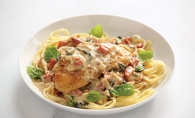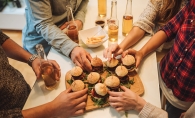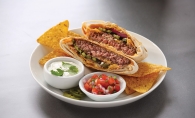
Creating the perfect tablescape can be daunting but with a little creativity, you can create an unforgettable spread fit for any occasion. To start, consider what elements you already have. Reuse them so that you don’t have to splurge on seasonal decorations. These items could include anything from a classic table runner, favorite candleholders or even mason jars and soup tureens. By reimagining what you already own, you can draw interest and diversify the table.
When dressing your table, less is more. This is the time to let your food shine. It is important to keep things simple and elegant, while still drawing interest through shape and textures of the food and supporting decor. Start with a basic foundation: Use neutral colors like white, cream, taupe and gray as the color scheme for your dishware settings. Plain plates, bowls and glasses will allow items such as placemats, table runners, napkins, name placecards and vases to shine.
Top Table Tips
Mixture of elements: Mother nature is your best friend when it comes to vibrant color and texture. Bring in traditional elements like pine, wood slabs, branches, pinecones and flowers; or incorporate seasonal produce like squash, pumpkins, cranberries, pears and oranges. These organic elements incorporate a natural effect, which is also practical and budget friendly.
Create an edible centerpiece from a charcuterie board filled with a variety of cheeses, fresh seasonal produce, herbs topped with handmade labels. Place the food on a slab of wood or use a cake stand to create heightened look that will draw interest to the tasty snacks.
Carve out the inside of small sugar pumpkins or butternut squashes to create vases for a flourishing bouquet filled with chrysanthemums, goldenrod, mums, dahlias and even succulents.
Elevate your tablescape and add variations of candles for pops of color, height and a twinkling light. Or use glass vases to add height and fill them with clusters of natural elements like branches and berries for a whimsical effect.
Set the Table
Know what types of food will be served and the total number of guests—always prep for a few additional guests, too! With this information, decide how many utensils and dishes needed around the table, then decorate.
- Stack the smaller salad plate on top of the large entrée plate and finish it off with a patterned or colored folded napkin to add a pop of color.
- Place the bread plate in the upper left corner above the main plates.
- The dinner fork goes to the left of the main plates. The salad fork goes to the left of the dinner fork.
- Place the knife to the right of the dinner plate and the soup spoon alongside it, to the right of the knife.
- The dessert spoon lies horizontally above the dinner plate.
- The drinkware should be placed opposite of the bread plate in the upper right corner of the place setting, starting closest with the water glass and red and wine glasses to follow.
Set the Kids Table, Too!
To ensure the safety of ceramic or glasses dishes, swap the kids plates and bowls for plastic and paper alternatives. Fun, decorative plates (think cartoon turkeys or fall colors) will excite the little ones. Instead of glass cups, use the aforementioned alternatives or cups with lids for the toddlers. And don’t forget about festive napkins—a must for the kids table.
For added fun, create a coloring sheet placemat accompanied with a cup of crayons or colored pencils for the kids at the gathering. This will ensure that they stay occupied and is a clean form of entertainment. Or create a brown paper table runner, where the kiddos will have plenty of space to play and color.









